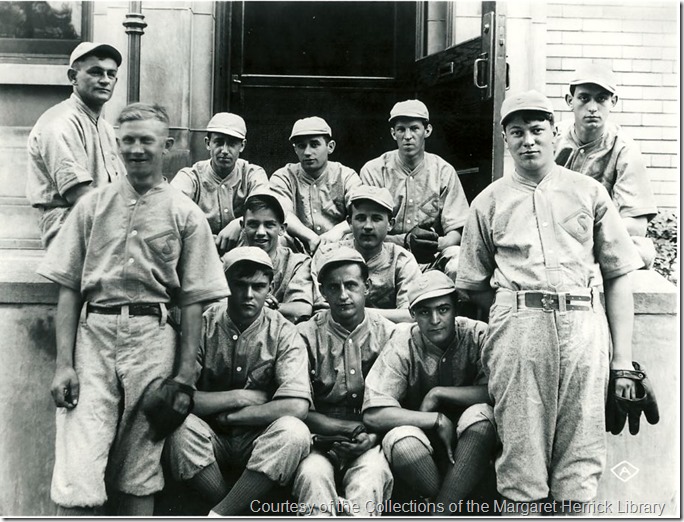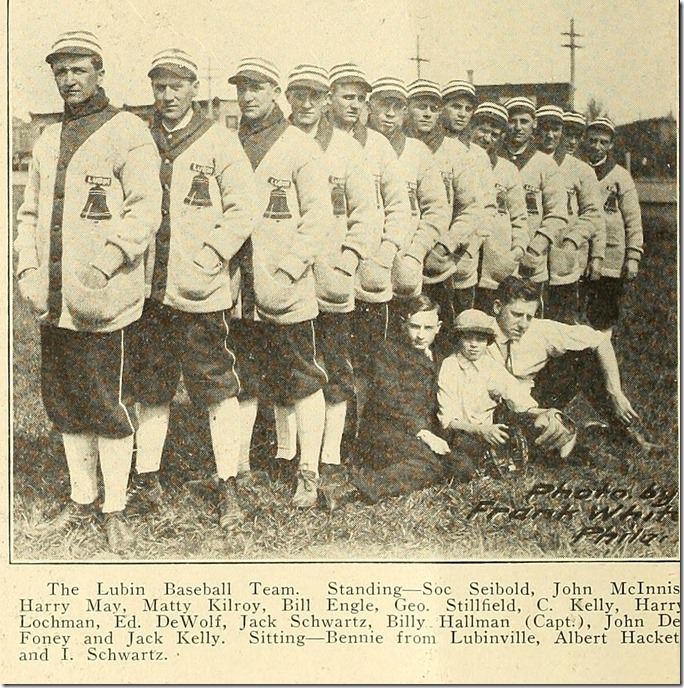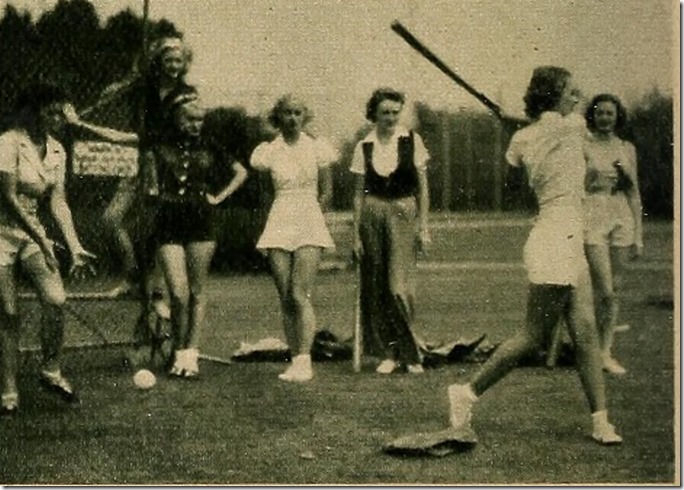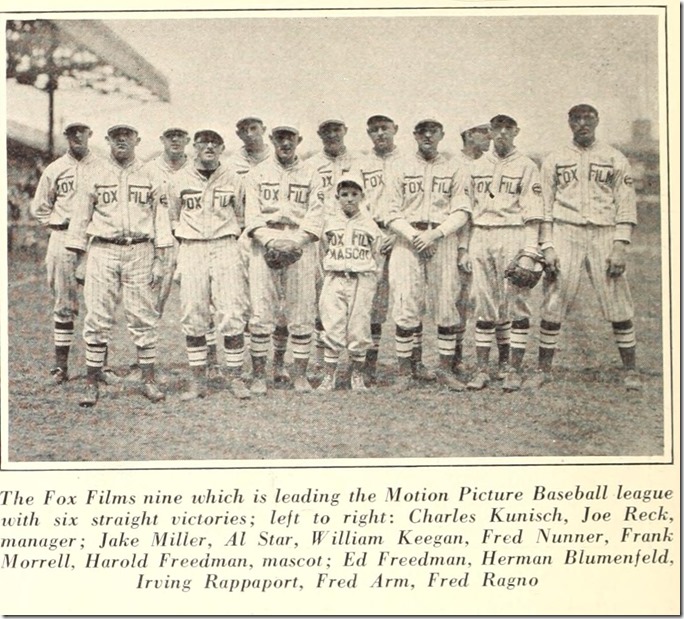
The Selig baseball team, courtesy of the Collections of the Margaret Herrick Library
Long before there was radio, television, the Internet, social media, computer games or rotisserie leagues, major league baseball dominated the American landscape. For decades, it filled newspaper sports pages, led social chatter, taught teamwork and sportsmanship and trimmed American waistlines. More Americans played baseball than any other sport into the middle of the 20th century.
In many ways, baseball shaped American culture: sublimating individual play into teamwork, democratizing and integrating citizens, giving hope for the future, offering a chance at the American dream. Baseball represented the national pastime, and America itself. In 1888, Walt Whitman pointed out, “I like your interest in sports — ball, chiefest of all — base-ball particularly: base-ball is our game: the American game: I connect it with our national character.” “Baseball in America” states that Mark Twain called it “the very symbol, the outward and visible expression of the drive and push and rush and struggle of the raging, tearing, booming 19th century.”
Mary Mallory’s “Hollywoodland: Tales Lost and Found” is available for the Kindle.

As The Sporting Life pointed out in a 1911 editorial, “In the United States base ball deserves its title of the national game, not only because it has more devotees than any other amusement and not alone because this country perfected the sport and brought it to its present form, but also because it is essentially a game of no one race or creed.… In the stress of a contest … all nationalities merge and race prejudice are forgotten.”
The meteoric rise and popularity of baseball in the 1800s inspired Americans of all stripes and shapes to participate in watching or playing. Professional and semipro teams organized, and colleges and high schools quickly added the sport. Cities and towns large and small organized teams and formed leagues to play the game, as did various professions. The book “The Rise of Baseball in Minnesota” quotes a passage from an 1867 newspaper describing the importance of baseball: “The game of baseball has become so much the style that nearly every village and hamlet has its club, and to be a member of the first nine is now looked upon as being nearly as honorable a position as a seat in the legislature.”
Players demonstrated determination, confidence, discipline, swagger, character, frustration, sacrifice, drive, hope and despair, all in turn. One moment a player drove in the winning run; the next, he dropped an easy pop fly leading to defeat. What more perfect game could act as metaphor for making films: how the backbreaking, dedicated work of individual men and women combined together could create the grace, power and grit of a successful motion picture?
The fledgling entertainment and moving picture industry quickly embraced the game, forming teams to compete against one another, just as they did in the marketplace. The Sept. 1, 1906, Variety mentions that Harry Mock recruited players from Hammerstein’s Theatre into a team called the Victorias, all ardent “ringers,” to compete against the Police Department’s team.


The 20th Century Fox women’s team.
Selig and Essanay Film Cos. dominated play on the West Coast, scheduling series against each other in 1912. Selig’s win gave them the championship of the West, with a July 1912 Moving Picture World article noting that they would soon compete against the Pathe Roosters, the East Coast winner, for the title of motion picture baseball champion at the Exhibitors National Convention. Pathe had advanced after beating Lubin Film Co. with a triple play June 30, 1912.
Earlier in June, Moving Picture World revealed the high popularity of baseball among the East Coast film studios. “The baseball fever has hit the New York picture men hard. Almost every manufacturing plant and exchange in the vicinity of New York has an organized baseball team and field. The Pathe team comprises the staff at the Jersey City Heights Studio and has an almost unbroken record of victories.”
All areas of entertainment fielded teams: theaters, film companies, trade papers and photography studios. The film magazines and newspapers listed teams playing for White Photography Studios, Variety, Loew’s, Fox Film Co., Pantages Theatre, the Actor’s Union, Hammerstein’s, the Palace, etc., many with elaborate uniforms and playing at nationally recognized parks like the Polo Grounds. Some stories gave box scores and noted important plays.
Many stars played on teams. Al Ernest Garcia coached the Selig team. Robert Z. Leonard played in Universal’s starting lineup in 1913. Roscoe “Fatty” Arbuckle joined the fledgling Keystone Co. team in 1914, cheered on by Mabel Normand. Carlyle Blackwell played shortstop on the Famous Players team.

Winning was the name of the game; teams found “ringers” to add heft to their lineups. G. M. “Broncho Billy” Anderson brought in Rollie Totheroh from a neighboring town to help beef up the Essanay Film Co.’s team in Niles, Calif. In 1913, they brought in pitcher Frank “Fodder” Dolan, an experienced semipro player from the Pacific Coast, per David Kiehn in his book, “Broncho Billy and the Essanay Film Company.” Wid’s Daily reported Nov. 11, 1919, that Maxwell Karger of Metro signed three major league stars (Chicago White Sox third baseman Fred McMullen, Carl Sawyer of Minnesota, and “Irish” Mansel of the Philadelphia Nationals) to act before the camera and then play on Metro’s Southern California winter baseball team.
Ince Studio ended up with two teams for a short while in 1919 while making the baseball film, “The Busher.” Star Charles Ray, playing a pitcher in the film, organized actors, writers and directors who had played intercollegiate or semipro ball to compete against the regular Ince team composed of “husky young men” from the carpenters, stage hands, electricians and others, per the July 10, 1919, Los Angeles Times. Ray supposedly pitched his team to a convincing 7-2 victory in the Sunday afternoon game.
Teams played against each other to raise money for charity as well. During World War I, “Comedians” took on the “Tragics” for the benefit of the Red Cross, with Charlie Chaplin hurling pitches to Universal star Herbert Rawlinson.
Women even joined the action, when Ida Schnall organized a female baseball team at Universal in December 1915. Schnall, a former captain and organizer of the New York Female Giants team, was wintering in Los Angeles while starring in “Undine.” Twenty young women from around the lot, including actresses, joined the team. “Not the least surprising thing about it all is the ability shown by the applicants in a sport generally conceded to be without the ken of the fair sex,” Moving Picture Weekly stated on Dec. 4, 1915. The article noted that the women practiced in gym suits while awaiting the arrival of uniforms, and practiced on a field laid out on the Parade Grounds. Schnall starred as lead pitcher, with Laura Oakley in reserve. Cleo Madison and Betty Schade battled for the catcher’s position, Jane Novak and Dixie were neck and neck competing for the first base start, and Maude George secured the second baseman position.
Through the 1920s and 1930s, fierce competition reigned between the various film teams in the Motion Picture Baseball League, a loose group that organized itself each year for play. Various studios, production facilities and entertainment conglomerates formed teams to battle each other for dominion on the baseball field as well as the box office. By the early 1930s, East Coast teams competed for the Martin Quigley Baseball Championship Trophy.
After World War II, studios organized recreational leagues on their lots to foster social relations among their employees, and inter-league competition between film industry companies declined. The rise of other sports like football, basketball and bowling also decreased baseball participation. Some competition still exists today, but nothing as fierce as the early days of the fledgling film industry.


Wonderful story.
Just one question: did the little boy in the Lubin team photo (identified in the caption as Albert Hackett) grow up to become the award-winning screenwriter Albert Hackett?
LikeLike
I would assume so, Carol. That’s the only Albert Hackett I know of.
LikeLike
It very well could be. His mother, Florence Hackett, was an actress in several Lubin Co. movies between 1911 and 1915.
LikeLike